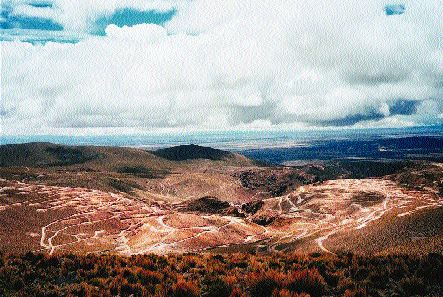Vancouver — Road construction and other infrastructure are progressing at the San Cristobal silver-zinc project in southwestern Bolivia and
Situated in the Potosi district, San Cristobal is the world’s largest open-pit silver reserve and one of the largest zinc reserves.
Since its formation in 1993, Apex has focused on silver throughout the Americas. A US$50-million initial public offering in 1997, combined with a listing on the American Stock Exchange, bolstered the company’s treasury, allowing Apex to consolidate its San Cristobal land position and carry out drilling in an attempt to expand the silver resource.
Subsequent drilling led to a positive feasibility study in 1999, which called for an open-pit silver-lead-zinc mine. A projected stripping ratio of 1.8-to-1 coupled with favourable topography and orebody geometry indicated low operating costs.
The study estimated an initial mining rate of 40,000 tonnes per day, with annual silver production pegged at 24 million oz. Capital costs were projected at US$413 million, and in the second phase of operations (starting in the sixth or seventh year), the daily mining rate would increase to 60,000 tonnes.
On the heels of the feasibility, Apex launched a US$97-million equity financing to fund development, and the company quickly became a darling among institutional investors looking for exposure to silver.
Between 2000 and 2003, Apex carried out metallurgical studies and negotiated contracts for power-supply and sale and shipment of concentrates.
Apex has decided to use contract miners over the entire life of the mine and promptly hired Washington Group International (formerly Morrison Knudsen) to do the job.
But the company’s plan to achieve production by 2003 was frustrated by depressed silver prices, which touched a new low of US$4.07 per oz. in late 2001. Fortunately, a price surge in late 2003 to greater than US$7 per oz. put the project back on track.
Buoyant silver prices boosted Apex’s share price to a high of US$24 early in 2004, whereupon the company arranged more than US$500 million in various financings to cover looming development costs.
San Cristobal is now expected to operate for 16 years. Annual production in the first five years is pegged at 22 million oz. silver at a cash cost of US$1.31 per oz. During this period, the mine is also expected to crank out 180,000 tonnes of zinc at a cash cost of US39 per lb. and 85,000 tonnes lead at an undisclosed cost.
The revised capital cost is US$585 million. Road construction is nearly complete and processing equipment has been ordered in preparation for the projected startup in late 2007.
The deposit has a proven and probable reserve of 219 million tonnes grading 64.7 grams silver per tonne, plus 1.6% zinc and 0.6% lead, equivalent to 456 million oz. silver, 3.5 million tonnes (7.7 billion lbs.) zinc, and 1.3 million tonnes (2.8 billion lbs.) lead. The estimates are based on prices of US$5.37 per oz. silver, US40 per lb. zinc, and US29 per lb. lead.
Based on contained metals, the project is the world’s second-largest silver deposit, behind
Bolivia’s political regime is uncertain. President Carlos Mesa recently offered to resign following widespread protests over his economic policies; however, Congress has decided to support him.
Mesa, an independent with no formal party affiliation, took office in late 2003 following the resignation of Gonzalo Sanchez de Lozada over widespread opposition to planned natural gas exports.
Bolivia, with a population of about 9 million, has seen an increased polarization between its politically strengthened native majority and the traditional seat of power held by the white and mixed-race class.
Apex Silver is also exploring for silver in Bolivia, Peru and Mexico. Shares recently traded in a 52-week range of US$15.08-23.18. With more than 47.5 million shares outstanding, the company has a market capitalization of US$760 million.


Be the first to comment on "Apex Silver develops giant at San Cristobal"